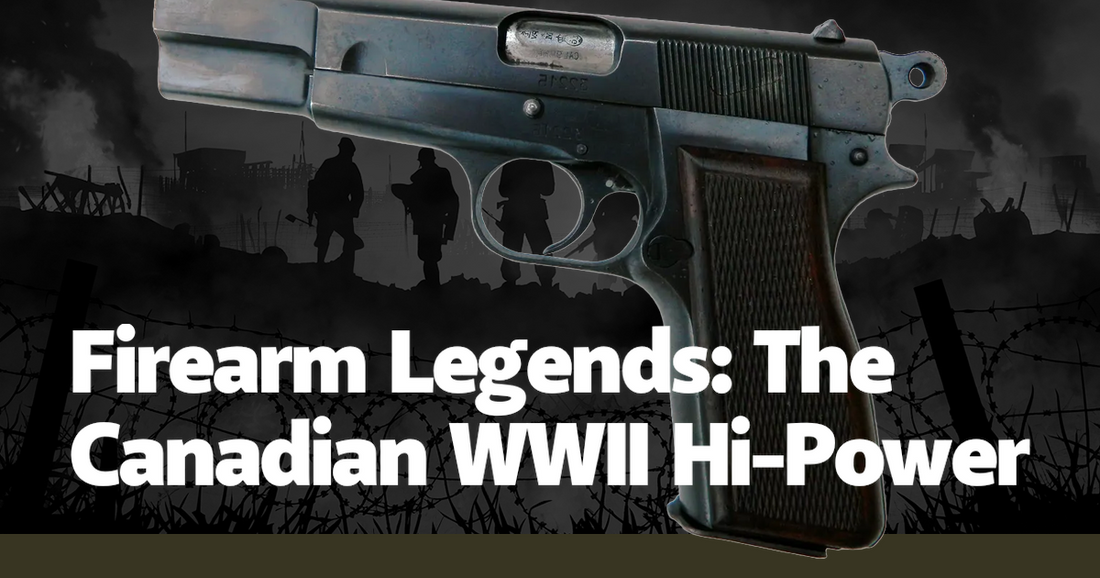The Second World War was a crucible of innovation, a period where necessity drove the rapid development of weaponry across the globe. Among the myriad of firearms that emerged from this era, the Canadian WWII Hi-Power stands out not just for its technical prowess but for the rich tapestry of stories and legends that surround it. The Hi-Power, a brainchild of the brilliant Belgian designer John Browning and later refined by Dieudonné Saive, found an unexpected home in the hands of Canadian soldiers. This pistol, known for its high-capacity magazine and robust design, became a symbol of reliability and firepower in the chaos of war.
The journey of the Hi-Power to Canadian hands is a tale of resilience and ingenuity. After the fall of Belgium to Nazi forces, the production of the Hi-Power at the Fabrique Nationale factory in Herstal was commandeered by the Germans. However, the blueprints and knowledge of this remarkable firearm had already crossed the Atlantic, finding sanctuary in Canada. The John Inglis and Company in Toronto took up the mantle, producing the Hi-Power for Allied forces. This transition was not seamless; it required significant adaptation and the overcoming of numerous technical challenges. Yet, the determination of Canadian engineers and workers ensured that the Hi-Power would see the light of day, ready to serve in the hands of those fighting for freedom.
Canadian soldiers quickly grew to appreciate the Hi-Power for its exceptional performance in the field. Unlike many of its contemporaries, the Hi-Power boasted a 13-round magazine, a significant advantage over the standard 7 or 8 rounds of other pistols. This increased capacity, coupled with its 9mm Parabellum cartridge, provided a balance of firepower and manageability that was unmatched. Anecdotes from the front lines often highlight the Hi-Power’s reliability in adverse conditions, from the freezing winters of the European front to the humid jungles of Southeast Asia. Its ability to function flawlessly in such diverse environments cemented its reputation among Canadian troops.
One particularly compelling story involves a Canadian officer during the Battle of the Scheldt in 1944. Surrounded and outnumbered, he and his men faced a dire situation. The officer’s Hi-Power, with its generous magazine capacity, played a crucial role in holding off enemy forces until reinforcements arrived. This incident, among many others, contributed to the Hi-Power’s legendary status. Soldiers would often personalize their Hi-Powers, engraving names or symbols onto the metal, turning each firearm into a unique piece of wartime history.
The Hi-Power’s influence extended beyond the battlefield. Its design and production in Canada had a lasting impact on the country’s post-war firearms industry. The expertise gained by John Inglis and Company during the war laid the groundwork for future innovations in Canadian arms manufacturing. Moreover, the Hi-Power’s success helped to establish Canada as a key player in the global arms market, a legacy that persists to this day. The pistol’s design also influenced subsequent generations of handguns, with its high-capacity magazine becoming a standard feature in modern semi-automatic pistols.
In the post-war years, the Hi-Power continued to serve with distinction. It became a standard issue for military and law enforcement agencies around the world, from the British Army to the FBI. Its longevity is a testament to the soundness of its design and the quality of its construction. Even today, the Hi-Power is revered by collectors and enthusiasts, who prize it not only for its historical significance but also for its enduring performance. The Canadian WWII Hi-Power remains a symbol of resilience, ingenuity, and the unyielding spirit of those who wielded it.
The stories and legends of the Canadian WWII Hi-Power are a testament to the men and women who brought it to life and those who relied on it in the heat of battle. It is more than just a firearm; it is a piece of history, a symbol of a time when the world was engulfed in conflict, and every advantage could mean the difference between life and death. The Hi-Power’s legacy is etched not only in the annals of military history but also in the hearts of those who carried it into battle.
In conclusion, the Canadian WWII Hi-Power stands as a remarkable example of wartime innovation and collaboration. Its journey from Belgian design to Canadian production, and its subsequent impact on the battlefield and beyond, make it a fascinating subject of study. The Hi-Power’s story is one of resilience, adaptability, and excellence, qualities that resonate deeply with the values of those who fought for freedom during World War II. As we reflect on the past, the legends of the Canadian WWII Hi-Power remind us of the enduring importance of ingenuity and determination in the face of adversity.

